Paper Menu >>
Journal Menu >>
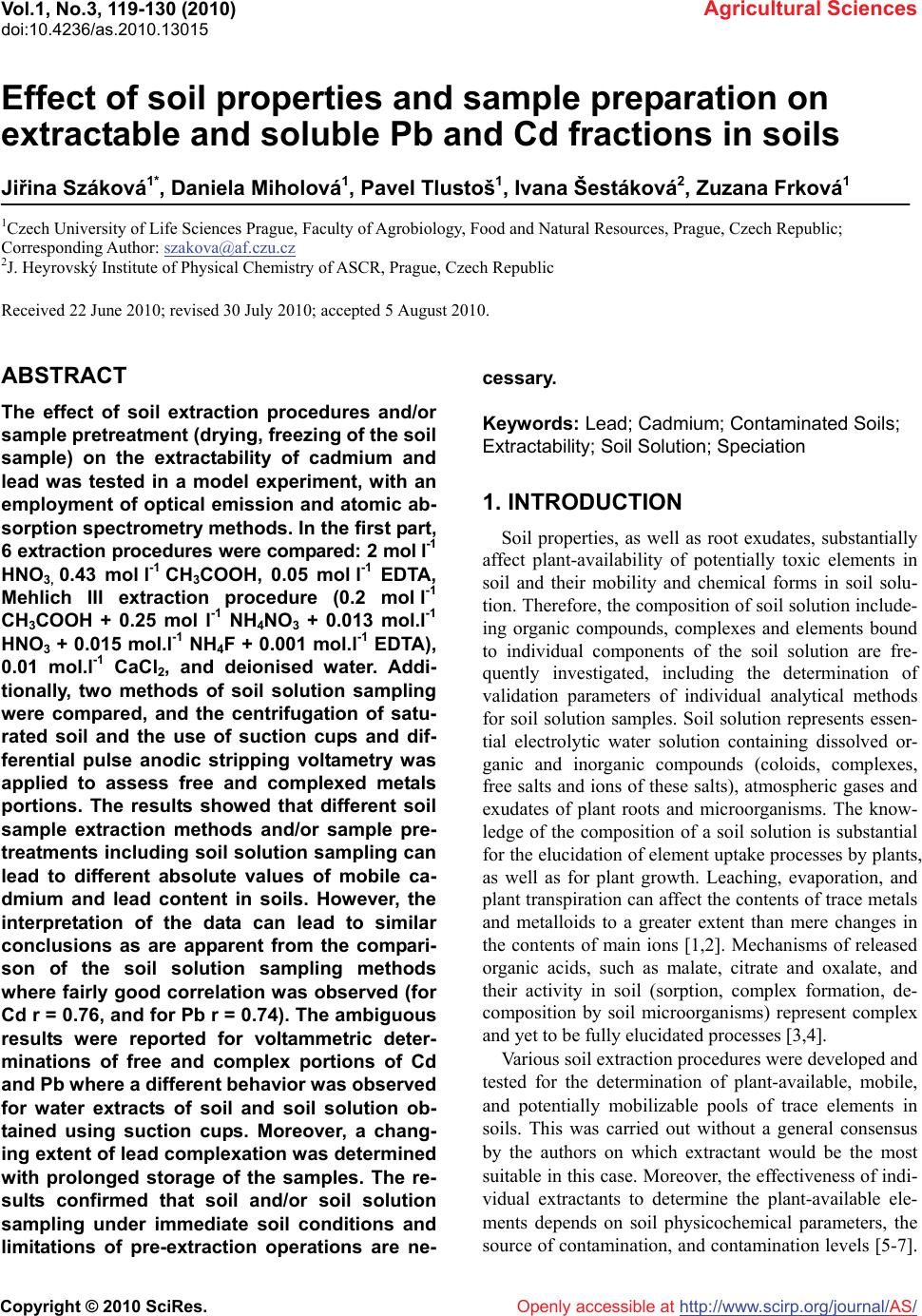 Vol.1, No.3, 119-130 (2010) Agricultural Sciences doi:10.4236/as.2010.13015 Copyright © 2010 SciRes. Openly accessible at http:// www.scirp.org/journal/AS/ Effect of soil properties and sample preparation on extractable and soluble Pb and Cd fractions in soils Jiřina Száková1*, Daniela Miholová1, Pavel Tlustoš1, Ivana Šestáková2, Zuzana Frková1 1Czech University of Life Sciences Prague, Faculty of Agrobiology, Food and Natural Resources, Prague, Czech Republic; Corresponding Author: szakova@af.czu.cz 2J. Heyrovský Institute of Physical Chemistry of ASCR, Prague, Czech Republic Received 22 June 2010; revised 30 July 2010; accepted 5 August 2010. ABSTRACT The effect of soil extraction procedures and/or sample pretreatment (drying, freezing of the soil sample) on the extractability of cadmium and lead was tested in a model experiment, with an employment of optical emission and atomic ab- sorption spectrometry methods. In the first part, 6 extraction procedures were compared: 2 mol l-1 HNO3, 0.43 mol l-1 CH3COOH, 0.05 mol l-1 EDTA, Mehlich III extraction procedure (0.2 mol l-1 CH3COOH + 0.25 mol l-1 NH4NO3 + 0.013 mol.l-1 HNO3 + 0.015 mol.l-1 NH4F + 0.001 mol.l-1 EDTA), 0.01 mol.l-1 CaCl2, and deionised water. Addi- tionally, two methods of soil solution sampling were compared, and the centrifugation of satu- rated soil and the use of suction cups and dif- ferential pulse anodic stripping voltametry was applied to assess free and complexed metals portions. The results showed that different soil sample extraction methods and/or sample pre- treatments including soil solution sampling can lead to different absolute values of mobile ca- dmium and lead content in soils. However, the interpretation of the data can lead to similar conclusions as are apparent from the compari- son of the soil solution sampling methods where fairly good correlation was observed (for Cd r = 0.76, and for Pb r = 0.74). The ambiguous results were reported for voltammetric deter- minations of free and complex portions of Cd and Pb where a different behavior was observed for water extracts of soil and soil solution ob- tained using suction cups. Moreover, a chang- ing extent of lead complexation was determined with prolonged storage of the samples. The re- sults confirmed that soil and/or soil solution sampling under immediate soil conditions and limitations of pre-extraction operations are ne- cessary. Keywords: Lead; Cadmium; Contaminated Soils; Extractability; Soil Solution; Speciation 1. INTRODUCTION Soil properties, as well as root exudates, substantially affect plant-availability of potentially toxic elements in soil and their mobility and chemical forms in soil solu- tion. Therefore, the composition of soil solution include- ing organic compounds, complexes and elements bound to individual components of the soil solution are fre- quently investigated, including the determination of validation parameters of individual analytical methods for soil solution samples. Soil solution represents essen- tial electrolytic water solution containing dissolved or- ganic and inorganic compounds (coloids, complexes, free salts and ions of these salts), atmospheric gases and exudates of plant roots and microorganisms. The know- ledge of the composition of a soil solution is substantial for the elucidation of element uptake processes by plants, as well as for plant growth. Leaching, evaporation, and plant transpiration can affect the contents of trace metals and metalloids to a greater extent than mere changes in the contents of main ions [1,2]. Mechanisms of released organic acids, such as malate, citrate and oxalate, and their activity in soil (sorption, complex formation, de- composition by soil microorganisms) represent complex and yet to be fully elucidated processes [3,4]. Various soil extraction procedures were developed and tested for the determination of plant-available, mobile, and potentially mobilizable pools of trace elements in soils. This was carried out without a general consensus by the authors on which extractant would be the most suitable in this case. Moreover, the effectiveness of indi- vidual extractants to determine the plant-available ele- ments depends on soil physicochemical parameters, the source of contamination, and contamination levels [5-7]. 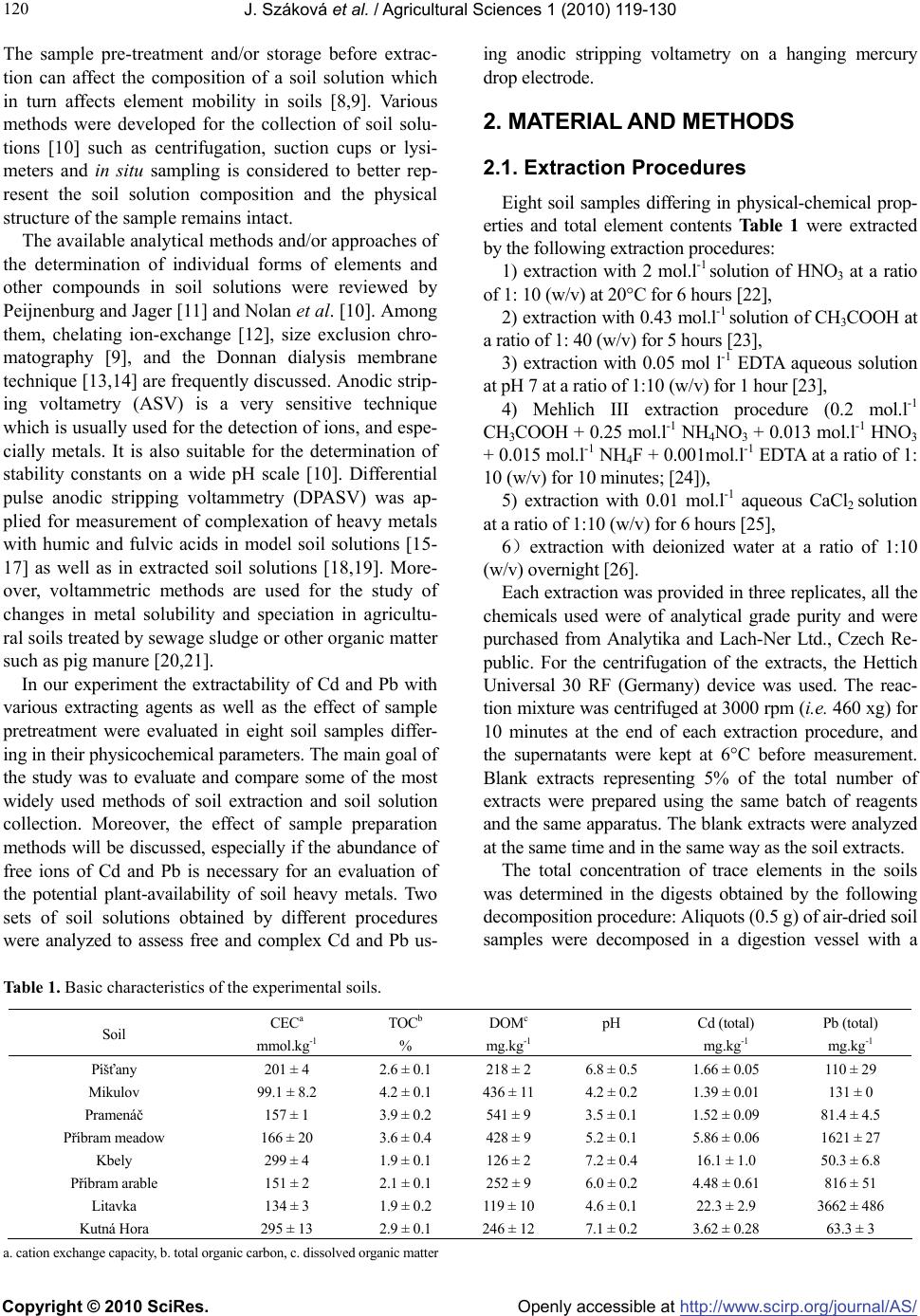 J. Száková et al. / Agricultural Sciences 1 (2010) 119-130 Copyright © 2010 SciRes. Openly accessible at http://www.scirp.org/journal/AS/ 120 The sample pre-treatment and/or storage before extrac- tion can affect the composition of a soil solution which in turn affects element mobility in soils [8,9]. Various methods were developed for the collection of soil solu- tions [10] such as centrifugation, suction cups or lysi- meters and in situ sampling is considered to better rep- resent the soil solution composition and the physical structure of the sample remains intact. The available analytical methods and/or approaches of the determination of individual forms of elements and other compounds in soil solutions were reviewed by Peijnenburg and Jager [11] and Nolan et al. [10]. Among them, chelating ion-exchange [12], size exclusion chro- matography [9], and the Donnan dialysis membrane technique [13,14] are frequently discussed. Anodic strip- ing voltametry (ASV) is a very sensitive technique which is usually used for the detection of ions, and espe- cially metals. It is also suitable for the determination of stability constants on a wide pH scale [10]. Differential pulse anodic stripping voltammetry (DPASV) was ap- plied for measurement of complexation of heavy metals with humic and fulvic acids in model soil solutions [15- 17] as well as in extracted soil solutions [18,19]. More- over, voltammetric methods are used for the study of changes in metal solubility and speciation in agricultu- ral soils treated by sewage sludge or other organic matter such as pig manure [20,21]. In our experiment the extractability of Cd and Pb with various extracting agents as well as the effect of sample pretreatment were evaluated in eight soil samples differ- ing in their physicochemical parameters. The main goal of the study was to evaluate and compare some of the most widely used methods of soil extraction and soil solution collection. Moreover, the effect of sample preparation methods will be discussed, especially if the abundance of free ions of Cd and Pb is necessary for an evaluation of the potential plant-availability of soil heavy metals. Two sets of soil solutions obtained by different procedures were analyzed to assess free and complex Cd and Pb us- ing anodic stripping voltametry on a hanging mercury drop electrode. 2. MATERIAL AND METHODS 2.1. Extraction Procedures Eight soil samples differing in physical-chemical prop- erties and total element contents Table 1 were extracted by the following extraction procedures: 1) extraction with 2 mol.l-1 solution of HNO3 at a ratio of 1: 10 (w/v) at 20°C for 6 hours [22], 2) extraction with 0.43 mol.l-1 solution of CH3COOH at a ratio of 1: 40 (w/v) for 5 hours [23], 3) extraction with 0.05 mol l-1 EDTA aqueous solution at pH 7 at a ratio of 1:10 (w/v) for 1 hour [23], 4) Mehlich III extraction procedure (0.2 mol.l-1 CH3COOH + 0.25 mol.l-1 NH4NO3 + 0.013 mol.l-1 HNO3 + 0.015 mol.l-1 NH4F + 0.001mol.l-1 EDTA at a ratio of 1: 10 (w/v) for 10 minutes; [24]), 5) extraction with 0.01 mol.l-1 aqueous CaCl2 solution at a ratio of 1:10 (w/v) for 6 hours [25], 6)extraction with deionized water at a ratio of 1:10 (w/v) overnight [26]. Each extraction was provided in three replicates, all the chemicals used were of analytical grade purity and were purchased from Analytika and Lach-Ner Ltd., Czech Re- public. For the centrifugation of the extracts, the Hettich Universal 30 RF (Germany) device was used. The reac- tion mixture was centrifuged at 3000 rpm (i.e. 460 xg) for 10 minutes at the end of each extraction procedure, and the supernatants were kept at 6C before measurement. Blank extracts representing 5% of the total number of extracts were prepared using the same batch of reagents and the same apparatus. The blank extracts were analyzed at the same time and in the same way as the soil extracts. The total concentration of trace elements in the soils was determined in the digests obtained by the following decomposition procedure: Aliquots (0.5 g) of air-dried soil samples were decomposed in a digestion vessel with a Table 1. Basic characteristics of the experimental soils. Soil CECa mmol.kg-1 TOC b % DOMc mg.kg-1 pH Cd (total) mg.kg-1 Pb (total) mg.kg-1 Píšťany 201 ± 4 2.6 ± 0.1 218 ± 2 6.8 ± 0.5 1.66 ± 0.05 110 ± 29 Mikulov 99.1 ± 8.2 4.2 ± 0.1 436 ± 11 4.2 ± 0.2 1.39 ± 0.01 131 ± 0 Pramenáč 157 ± 1 3.9 ± 0.2 541 ± 9 3.5 ± 0.1 1.52 ± 0.09 81.4 ± 4.5 Příbram meadow 166 ± 20 3.6 ± 0.4 428 ± 9 5.2 ± 0.1 5.86 ± 0.06 1621 ± 27 Kbely 299 ± 4 1.9 ± 0.1 126 ± 2 7.2 ± 0.4 16.1 ± 1.0 50.3 ± 6.8 Příbram arable 151 ± 2 2.1 ± 0.1 252 ± 9 6.0 ± 0.2 4.48 ± 0.61 816 ± 51 Litavka 134 ± 3 1.9 ± 0.2 119 ± 10 4.6 ± 0.1 22.3 ± 2.9 3662 ± 486 Kutná Hora 295 ± 13 2.9 ± 0.1 246 ± 12 7.1 ± 0.2 3.62 ± 0.28 63.3 ± 3 a. cation exchange capacity, b. total organic carbon, c. dissolved organic matter  J. Száková et al. / Agricultural Sciences 1 (2010) 119-130 Copyright © 2010 SciRes. Openly accessible at http://www.scirp.org/journal/AS/ 121 121 mixture of 8 ml concentrated nitric acid, 5 ml of hydro- chloric acid, and 2 ml of concentrated hydrofluoric acid. The mixture was heated in an Ethos 1 (MLS GmbH, Germany) microwave assisted wet digestion system for 33 min at 210°C. After cooling, the digest was quantitatively transferred into a 50 ml Teflon® vessel and evaporated to dryness at 160°C. The digest was then dissolved in a 3 ml nitric and hydrochloric acid mixture (1:3), transferred into a 25 ml glass tube, filled with deionised water, and kept at laboratory temperature until measurement. A certified reference material RM 7001 Light Sandy Soil was applied for the quality assurance of analytical data. 2.2. Soil Sample Pre-Treatment Prior to extraction and total element content determina- tion, the soil samples were air-dried at 20°C, ground in a mortar and passed through a 2-mm plastic sieve. Alterna- tively, aliquots of the samples were extracted as moist samples immediately after soil sample collection while dry mass of the soils was determined separately. Finally, aliquots of the samples were frozen at −18°C for 14 days before being air dried, ground, and sieved. The effect of sample pre-treatment was tested for 0.05 mol l-1 EDTA, 0.01 mol l-1 CaCl2 and water extracts. 2.3. Soil Solution Element concentrations in soil solution are related to the element contents in plant biomass [27]. However, there are different approaches to soil solution collection. We tested 1) the centrifugation of fully saturated soil at 10000 rpm for 10 minutes and 2) the application of suc- tion cups, where specialized plastic suction cups (DI Gottfried Wieshammer, Wien, Austria) were applied to pots containing roughly 350 g of the soil at the beginning of the experiment to get a soil solution. The pots with the suction cups were filled to capacity with deionised water one day before suction and left for 24 hours to equilibrate. 10 ml of soil solution was regulerly sampled from each pot and immediately analyzed for Cd and Pb concentra- tions. The collection of the soil solution was repeated twice (14 and 28 days into the experiment). The design of the suction cup application and soil solution sampling was described in detail by Jaklová-Dytrtová et al. [28]. 2.4. Analytical Methods The total contents of Cd and Pb in soil digests and ex- tracts were determined by optical emission spectroscopy with inductively coupled plasma (ICP-OES) with axial plasma configuration, Varian, VistaPro (Australia). Cali- bration solutions were prepared in the corresponding ex- traction agents as follows, 100-500 µg l-1 for Cd, 100- 1000 µg l-1 Pb. The operating measurement wave-lengths for ICP-AES were 214.4 nm for Cd, and 220.4 nm for Pb. The measurement conditions for all lines were as follows: power 1.2 kW, plasma flow 15.0 l min-1, auxillary flow 0.75 l min-1, nebulizer flow 0.9 l min-1. For the determina- tion of low concentrations of Cd and Pb in soil solutions, water and 0.01 mol.l-1 CaCl2 extracts electrothermal atomic absorption spectrometry (ET-AAS) using the in- strument VARIAN AA280Z (Varian, Australia) equipped with a GTA120 graphite tube atomizer was applied. The operation conditions are summarized in Table 2. Water extracts [26] and soil solutions obtained with suction cups (first collection) were analyzed with differ- ential pulse anodic stripping voltametry (DPASV) on a hanging mercury drop electrode. Voltammetric measure- ments were carried out by means of a computer-controlled polarographic/voltammetric analyzer PC-ETP (Polaro- Sensors, Prague, Czech Republic). Experiments were per- formed using a three-electrode configuration, with Ag/ AgCl/KCl (3 mol.L-1) as a reference, and a Pt wire as an auxiliary electrode. 10 ml of 0.001 M sodium perchlorate was used as a supporting electrolyte. After degassing with Table 2. Operational conditions for ET-AAS determination of Cd and Pb in soil extracts and soil solutions. Cd Pb calibration mode calibration curve standard addition wavelenght (nm) 228.8 (0.5) 283.3 (0.5) background correction Zeeman Zeeman signal integration peak area peak area matrix modifier no (NH4)2HPO4 pyrolysis temp. 350°C 850°C atomization temp. 2100°C 2400°C concentration of bulk standard 3 µg/L 60 µg/L volume injected on platform 30 µL 30 µL 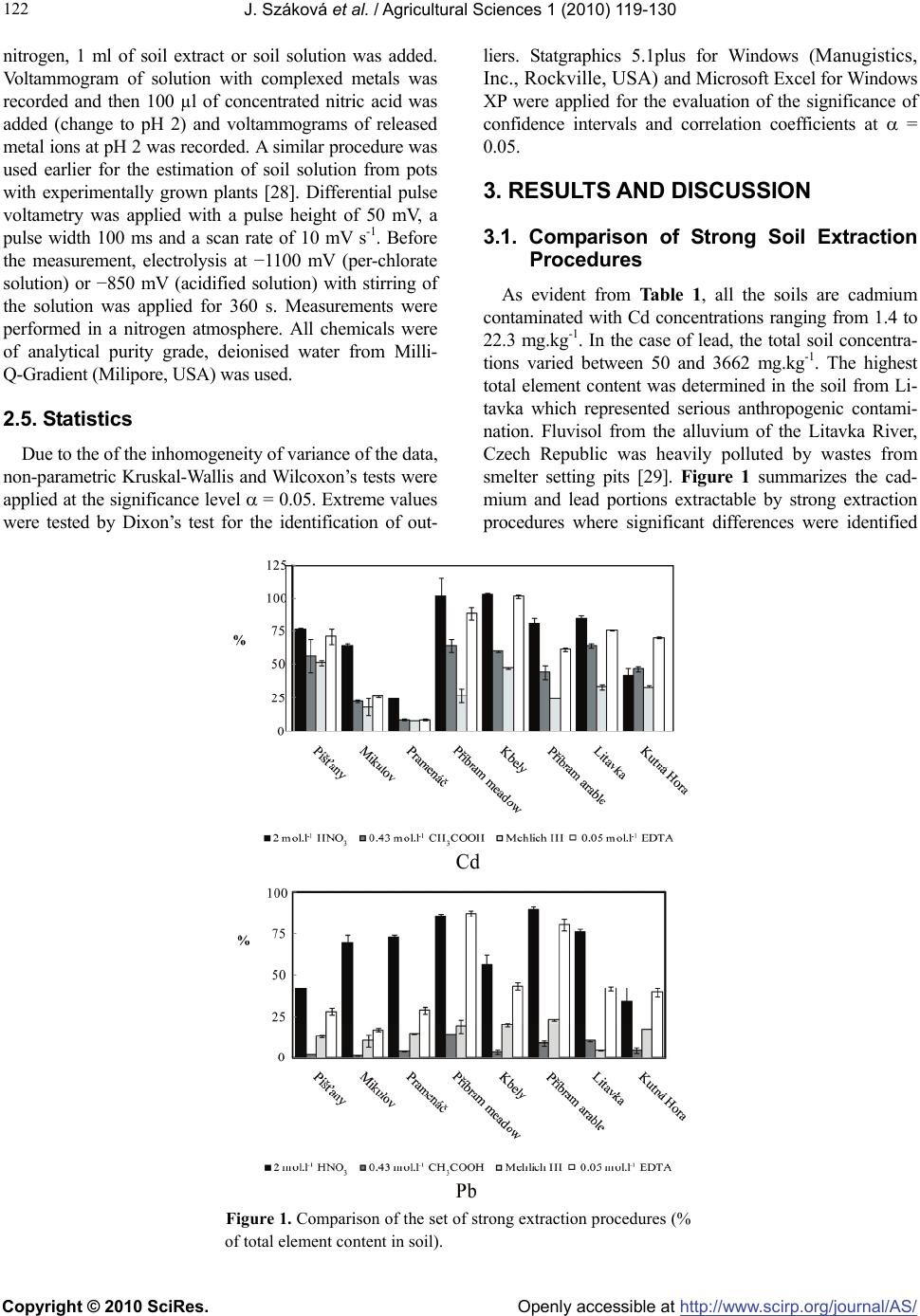 J. Száková et al. / Agricultural Sciences 1 (2010) 119-130 Copyright © 2010 SciRes. Openly accessible at http://www.scirp.org/journal/AS/ 122 nitrogen, 1 ml of soil extract or soil solution was added. Voltammogram of solution with complexed metals was recorded and then 100 µl of concentrated nitric acid was added (change to pH 2) and voltammograms of released metal ions at pH 2 was recorded. A similar procedure was used earlier for the estimation of soil solution from pots with experimentally grown plants [28]. Differential pulse voltametry was applied with a pulse height of 50 mV, a pulse width 100 ms and a scan rate of 10 mV s-1. Before the measurement, electrolysis at −1100 mV (per-chlorate solution) or −850 mV (acidified solution) with stirring of the solution was applied for 360 s. Measurements were performed in a nitrogen atmosphere. All chemicals were of analytical purity grade, deionised water from Milli- Q-Gradient (Milipore, USA) was used. 2.5. Statistics Due to the of the inhomogeneity of variance of the data, non-parametric Kruskal-Wallis and Wilcoxon’s tests were applied at the significance level = 0.05. Extreme values were tested by Dixon’s test for the identification of out- liers. Statgraphics 5.1plus for Windows (Manugistics, Inc., Rockville, USA) and Microsoft Excel for Windows XP were applied for the evaluation of the significance of confidence intervals and correlation coefficients at = 0.05. 3. RESULTS AND DISCUSSION 3.1. Comparison of Strong Soil Extraction Procedures As evident from Table 1, all the soils are cadmium contaminated with Cd concentrations ranging from 1.4 to 22.3 mg.kg-1. In the case of lead, the total soil concentra- tions varied between 50 and 3662 mg.kg-1. The highest total element content was determined in the soil from Li- tavka which represented serious anthropogenic contami- nation. Fluvisol from the alluvium of the Litavka River, Czech Republic was heavily polluted by wastes from smelter setting pits [29]. Figure 1 summarizes the cad- mium and lead portions extractable by strong extraction procedures where significant differences were identified Figure 1. Comparison of the set of strong extraction procedures (% of total element content in soil). 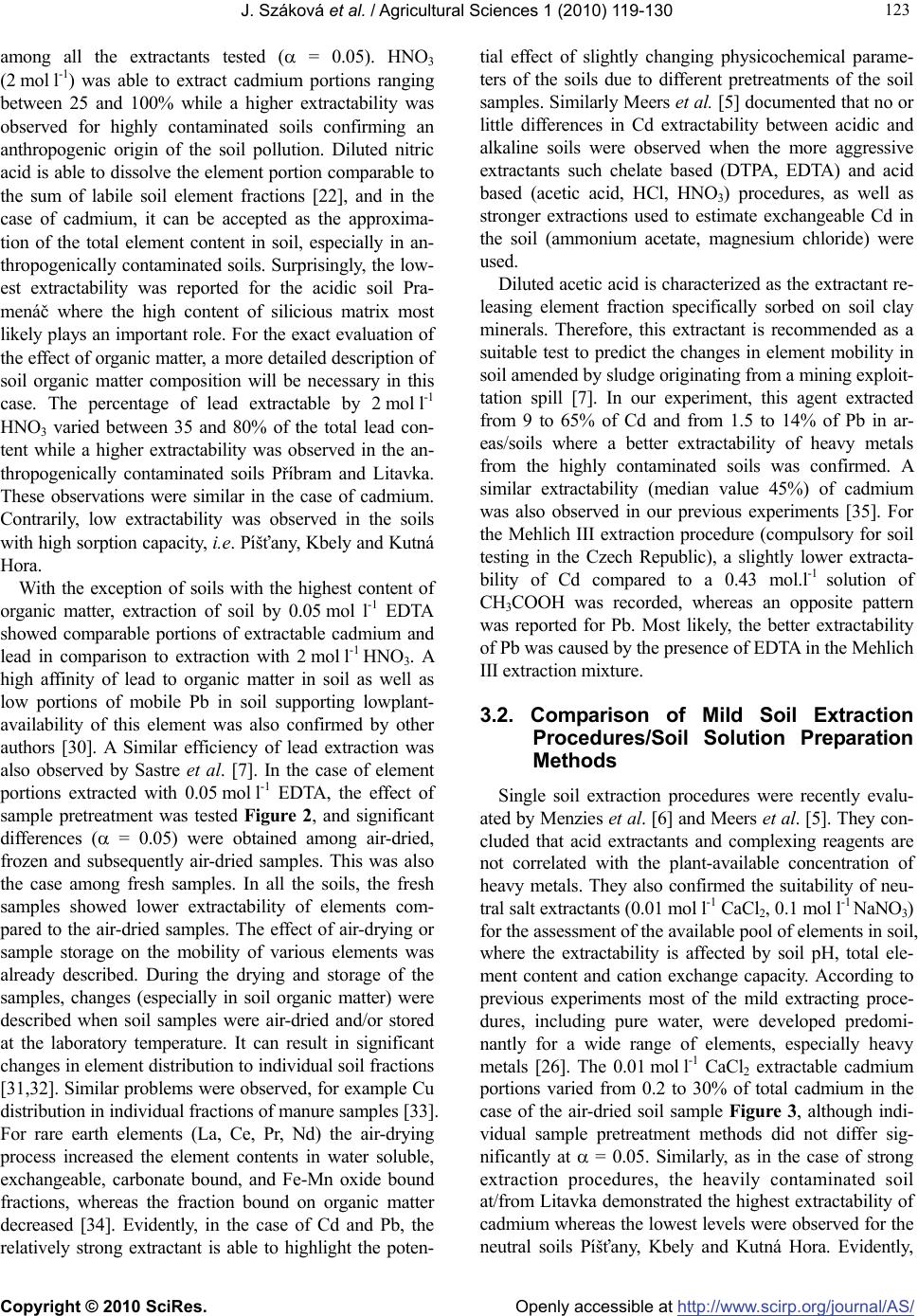 J. Száková et al. / Agricultural Sciences 1 (2010) 119-130 Copyright © 2010 SciRes. Openly accessible at http://www.scirp.org/journal/AS/ 123 123 among all the extractants tested ( = 0.05). HNO3 (2 mol l-1) was able to extract cadmium portions ranging between 25 and 100% while a higher extractability was observed for highly contaminated soils confirming an anthropogenic origin of the soil pollution. Diluted nitric acid is able to dissolve the element portion comparable to the sum of labile soil element fractions [22], and in the case of cadmium, it can be accepted as the approxima- tion of the total element content in soil, especially in an- thropogenically contaminated soils. Surprisingly, the low- est extractability was reported for the acidic soil Pra- menáč where the high content of silicious matrix most likely plays an important role. For the exact evaluation of the effect of organic matter, a more detailed description of soil organic matter composition will be necessary in this case. The percentage of lead extractable by 2 mol l-1 HNO3 varied between 35 and 80% of the total lead con- tent while a higher extractability was observed in the an- thropogenically contaminated soils Příbram and Litavka. These observations were similar in the case of cadmium. Contrarily, low extractability was observed in the soils with high sorption capacity, i.e. Píšťany, Kbely and Kutná Hora. With the exception of soils with the highest content of organic matter, extraction of soil by 0.05 mol l-1 EDTA showed comparable portions of extractable cadmium and lead in comparison to extraction with 2 mol l-1 HNO3. A high affinity of lead to organic matter in soil as well as low portions of mobile Pb in soil supporting lowplant- availability of this element was also confirmed by other authors [30]. A Similar efficiency of lead extraction was also observed by Sastre et al. [7]. In the case of element portions extracted with 0.05 mol l-1 EDTA, the effect of sample pretreatment was tested Figure 2, and significant differences ( = 0.05) were obtained among air-dried, frozen and subsequently air-dried samples. This was also the case among fresh samples. In all the soils, the fresh samples showed lower extractability of elements com- pared to the air-dried samples. The effect of air-drying or sample storage on the mobility of various elements was already described. During the drying and storage of the samples, changes (especially in soil organic matter) were described when soil samples were air-dried and/or stored at the laboratory temperature. It can result in significant changes in element distribution to individual soil fractions [31,32]. Similar problems were observed, for example Cu distribution in individual fractions of manure samples [33]. For rare earth elements (La, Ce, Pr, Nd) the air-drying process increased the element contents in water soluble, exchangeable, carbonate bound, and Fe-Mn oxide bound fractions, whereas the fraction bound on organic matter decreased [34]. Evidently, in the case of Cd and Pb, the relatively strong extractant is able to highlight the poten- tial effect of slightly changing physicochemical parame- ters of the soils due to different pretreatments of the soil samples. Similarly Meers et al. [5] documented that no or little differences in Cd extractability between acidic and alkaline soils were observed when the more aggressive extractants such chelate based (DTPA, EDTA) and acid based (acetic acid, HCl, HNO3) procedures, as well as stronger extractions used to estimate exchangeable Cd in the soil (ammonium acetate, magnesium chloride) were used. Diluted acetic acid is characterized as the extractant re- leasing element fraction specifically sorbed on soil clay minerals. Therefore, this extractant is recommended as a suitable test to predict the changes in element mobility in soil amended by sludge originating from a mining exploit- tation spill [7]. In our experiment, this agent extracted from 9 to 65% of Cd and from 1.5 to 14% of Pb in ar- eas/soils where a better extractability of heavy metals from the highly contaminated soils was confirmed. A similar extractability (median value 45%) of cadmium was also observed in our previous experiments [35]. For the Mehlich III extraction procedure (compulsory for soil testing in the Czech Republic), a slightly lower extracta- bility of Cd compared to a 0.43 mol.l-1 solution of CH3COOH was recorded, whereas an opposite pattern was reported for Pb. Most likely, the better extractability of Pb was caused by the presence of EDTA in the Mehlich III extraction mixture. 3.2. Comparison of Mild Soil Extraction Procedures/Soil Solution Preparation Methods Single soil extraction procedures were recently evalu- ated by Menzies et al. [6] and Meers et al. [5]. They con- cluded that acid extractants and complexing reagents are not correlated with the plant-available concentration of heavy metals. They also confirmed the suitability of neu- tral salt extractants (0.01 mol l-1 CaCl2, 0.1 mol l-1 NaNO3) for the assessment of the available pool of elements in soil, where the extractability is affected by soil pH, total ele- ment content and cation exchange capacity. According to previous experiments most of the mild extracting proce- dures, including pure water, were developed predomi- nantly for a wide range of elements, especially heavy metals [26]. The 0.01 mol l-1 CaCl2 extractable cadmium portions varied from 0.2 to 30% of total cadmium in the case of the air-dried soil sample Figure 3, although indi- vidual sample pretreatment methods did not differ sig- nificantly at = 0.05. Similarly, as in the case of strong extraction procedures, the heavily contaminated soil at/from Litavka demonstrated the highest extractability of cadmium whereas the lowest levels were observed for the neutral soils Píšťany, Kbely and Kutná Hora. Evidently, 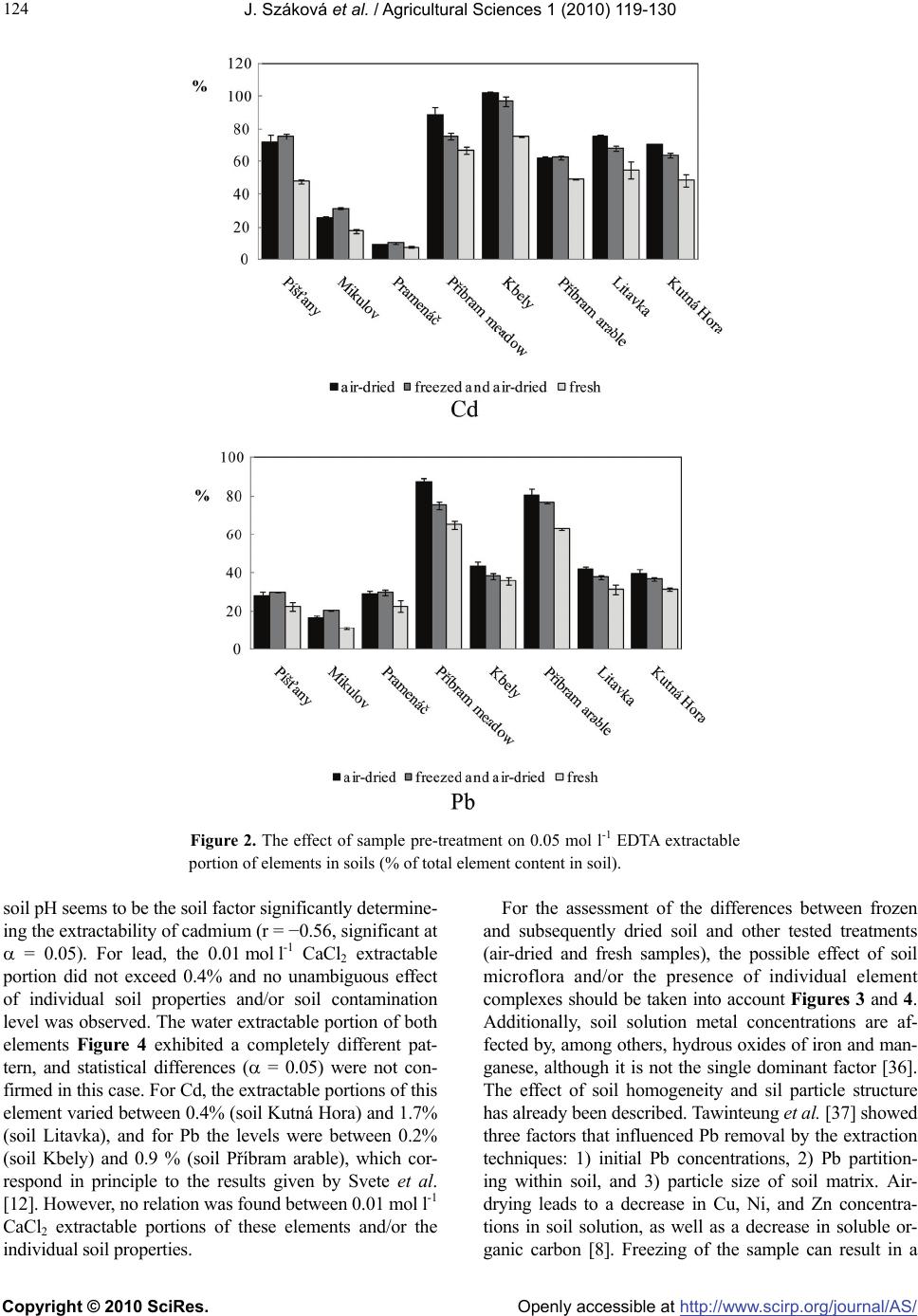 J. Száková et al. / Agricultural Sciences 1 (2010) 119-130 Copyright © 2010 SciRes. Openly accessible at http://www.scirp.org/journal/AS/ 124 Figure 2. The effect of sample pre-treatment on 0.05 mol l-1 EDTA extractable portion of elements in soils (% of total element content in soil). soil pH seems to be the soil factor significantly determine- ing the extractability of cadmium (r = −0.56, significant at = 0.05). For lead, the 0.01 mol l-1 CaCl2 extractable portion did not exceed 0.4% and no unambiguous effect of individual soil properties and/or soil contamination level was observed. The water extractable portion of both elements Figure 4 exhibited a completely different pat- tern, and statistical differences ( = 0.05) were not con- firmed in this case. For Cd, the extractable portions of this element varied between 0.4% (soil Kutná Hora) and 1.7% (soil Litavka), and for Pb the levels were between 0.2% (soil Kbely) and 0.9 % (soil Příbram arable), which cor- respond in principle to the results given by Svete et al. [12]. However, no relation was found between 0.01 mol l-1 CaCl2 extractable portions of these elements and/or the individual soil properties. For the assessment of the differences between frozen and subsequently dried soil and other tested treatments (air-dried and fresh samples), the possible effect of soil microflora and/or the presence of individual element complexes should be taken into account Figures 3 and 4. Additionally, soil solution metal concentrations are af- fected by, among others, hydrous oxides of iron and man- ganese, although it is not the single dominant factor [36]. The effect of soil homogeneity and sil particle structure has already been described. Tawinteung et al. [37] showed three factors that influenced Pb removal by the extraction techniques: 1) initial Pb concentrations, 2) Pb partition- ing within soil, and 3) particle size of soil matrix. Air- drying leads to a decrease in Cu, Ni, and Zn concentra- tions in soil solution, as well as a decrease in soluble or- ganic carbon [8]. Freezing of the sample can result in a 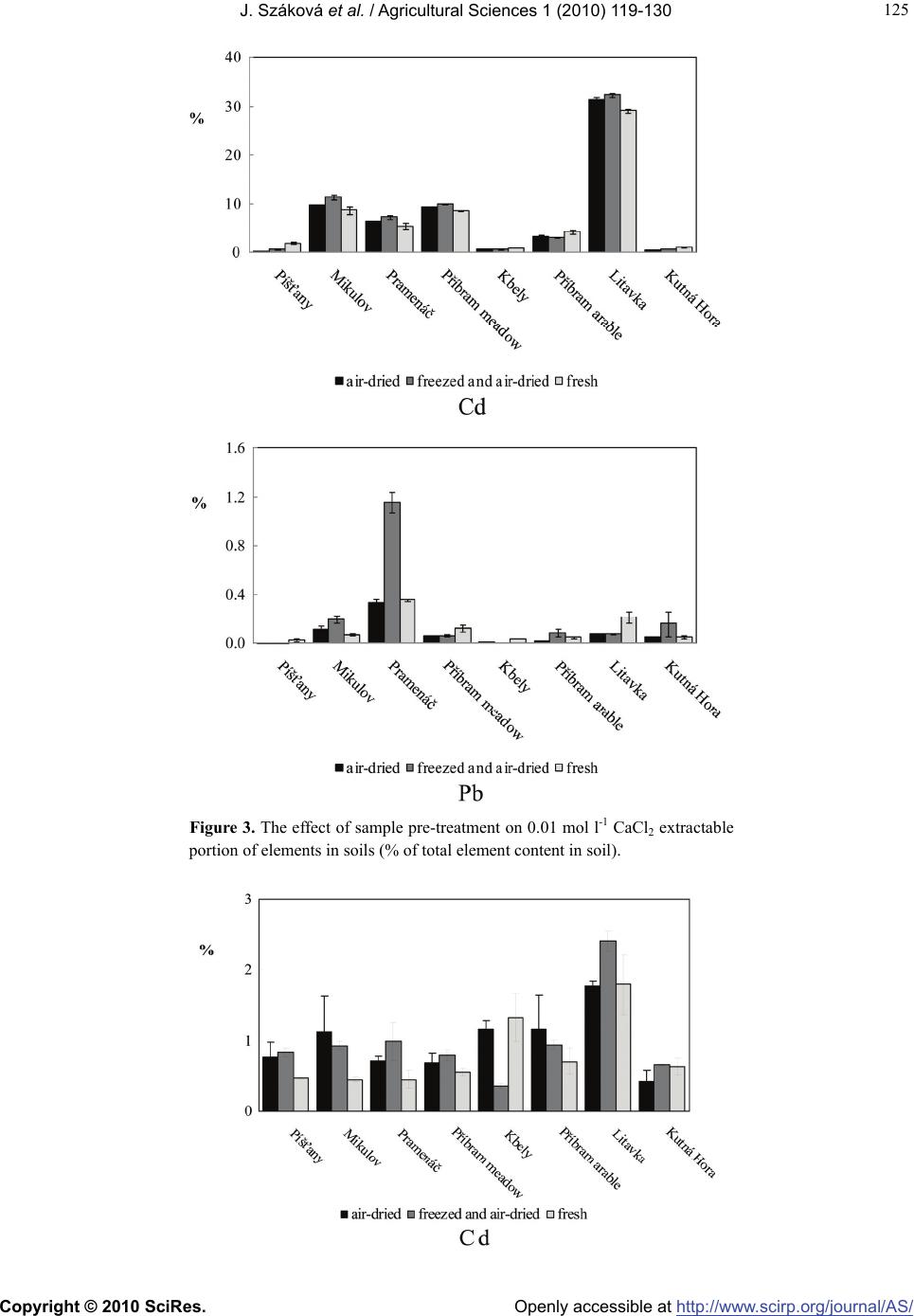 J. Száková et al. / Agricultural Sciences 1 (2010) 119-130 Copyright © 2010 SciRes. Openly accessible at http://www.scirp.org/journal/AS/ 125 125 Figure 3. The effect of sample pre-treatment on 0.01 mol l-1 CaCl2 extractable portion of elements in soils (% of total element content in soil). 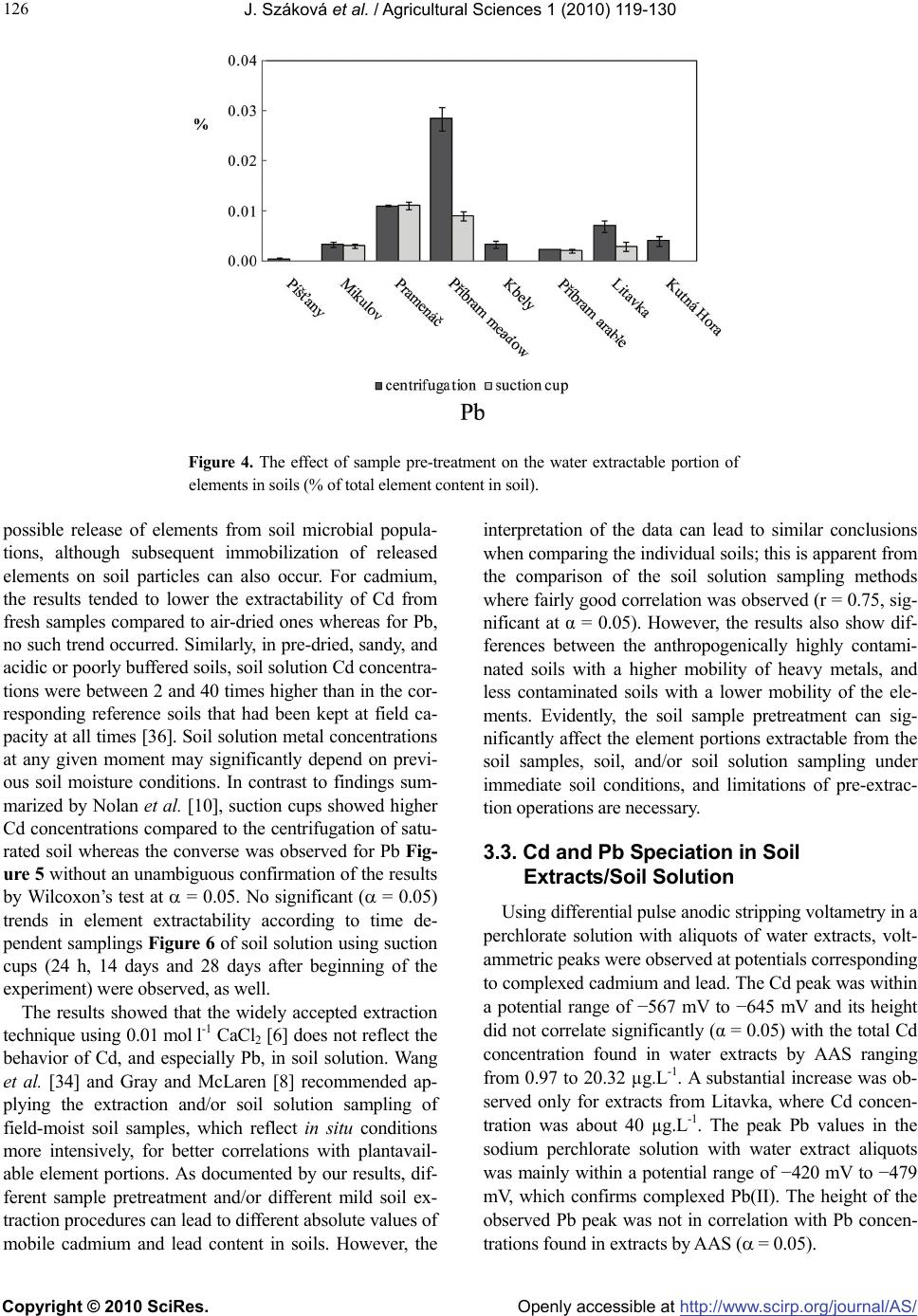 J. Száková et al. / Agricultural Sciences 1 (2010) 119-130 Copyright © 2010 SciRes. Openly accessible at http://www.scirp.org/journal/AS/ 126 Figure 4. The effect of sample pre-treatment on the water extractable portion of elements in soils (% of total element content in soil). possible release of elements from soil microbial popula- tions, although subsequent immobilization of released elements on soil particles can also occur. For cadmium, the results tended to lower the extractability of Cd from fresh samples compared to air-dried ones whereas for Pb, no such trend occurred. Similarly, in pre-dried, sandy, and acidic or poorly buffered soils, soil solution Cd concentra- tions were between 2 and 40 times higher than in the cor- responding reference soils that had been kept at field ca- pacity at all times [36]. Soil solution metal concentrations at any given moment may significantly depend on previ- ous soil moisture conditions. In contrast to findings sum- marized by Nolan et al. [10], suction cups showed higher Cd concentrations compared to the centrifugation of satu- rated soil whereas the converse was observed for Pb Fig- ure 5 without an unambiguous confirmation of the results by Wilcoxon’s test at = 0.05. No significant ( = 0.05) trends in element extractability according to time de- pendent samplings Figure 6 of soil solution using suction cups (24 h, 14 days and 28 days after beginning of the experiment) were observed, as well. The results showed that the widely accepted extraction technique using 0.01 mol l-1 CaCl2 [6] does not reflect the behavior of Cd, and especially Pb, in soil solution. Wang et al. [34] and Gray and McLaren [8] recommended ap- plying the extraction and/or soil solution sampling of field-moist soil samples, which reflect in situ conditions more intensively, for better correlations with plantavail- able element portions. As documented by our results, dif- ferent sample pretreatment and/or different mild soil ex- traction procedures can lead to different absolute values of mobile cadmium and lead content in soils. However, the interpretation of the data can lead to similar conclusions when comparing the individual soils; this is apparent from the comparison of the soil solution sampling methods where fairly good correlation was observed (r = 0.75, sig- nificant at α = 0.05). However, the results also show dif- ferences between the anthropogenically highly contami- nated soils with a higher mobility of heavy metals, and less contaminated soils with a lower mobility of the ele- ments. Evidently, the soil sample pretreatment can sig- nificantly affect the element portions extractable from the soil samples, soil, and/or soil solution sampling under immediate soil conditions, and limitations of pre-extrac- tion operations are necessary. 3.3. Cd and Pb Speciation in Soil Extracts/Soil Solution Using differential pulse anodic stripping voltametry in a perchlorate solution with aliquots of water extracts, volt- ammetric peaks were observed at potentials corresponding to complexed cadmium and lead. The Cd peak was within a potential range of −567 mV to −645 mV and its height did not correlate significantly (α = 0.05) with the total Cd concentration found in water extracts by AAS ranging from 0.97 to 20.32 µg.L-1. A substantial increase was ob- served only for extracts from Litavka, where Cd concen- tration was about 40 µg.L-1. The peak Pb values in the sodium perchlorate solution with water extract aliquots was mainly within a potential range of −420 mV to −479 mV, which confirms complexed Pb(II). The height of the observed Pb peak was not in correlation with Pb concen- trations found in extracts by AAS ( = 0.05). 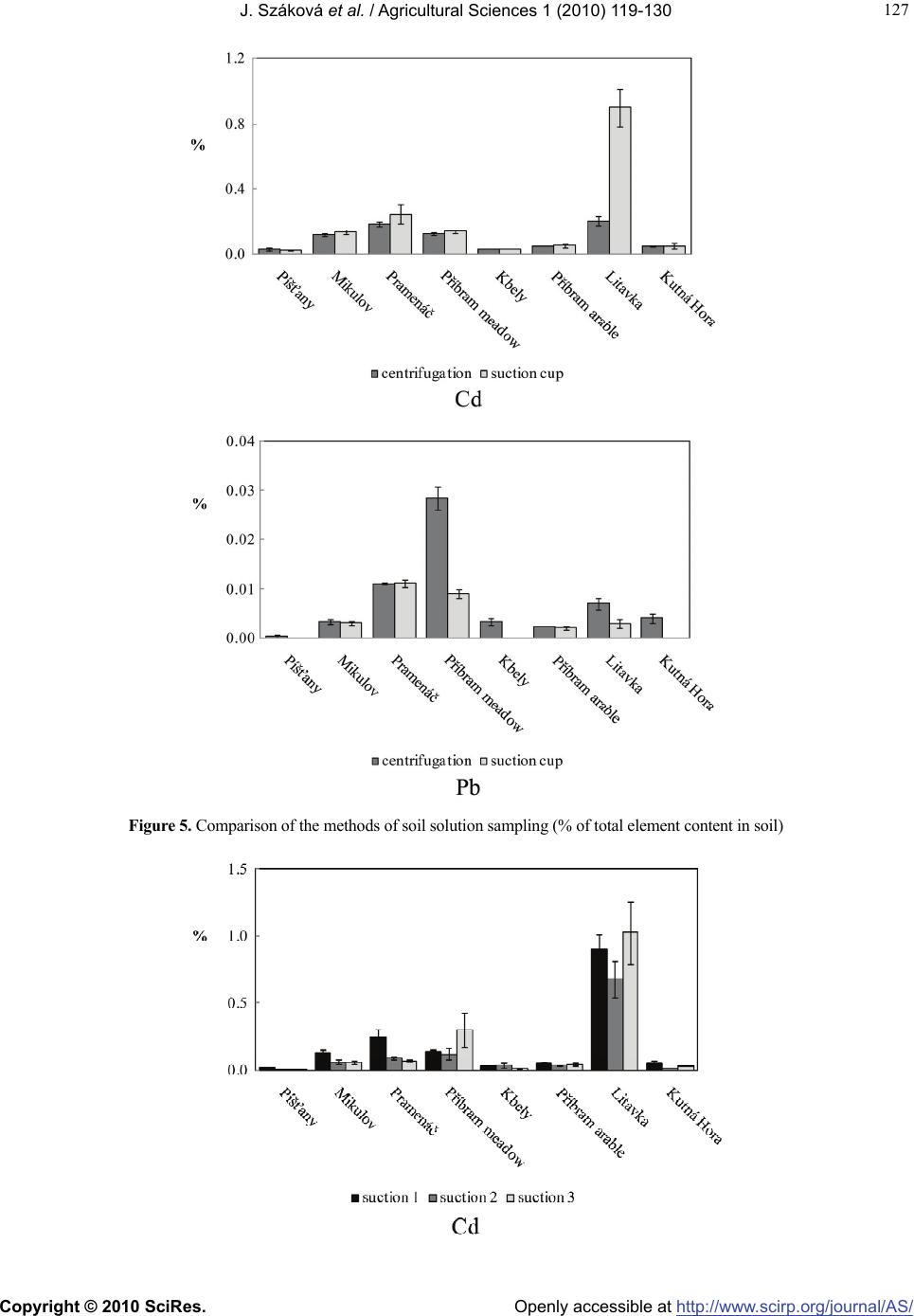 J. Száková et al. / Agricultural Sciences 1 (2010) 119-130 Copyright © 2010 SciRes. Openly accessible at http://www.scirp.org/journal/AS/ 127 127 Figure 5. Comparison of the methods of soil solution sampling (% of total element content in soil) 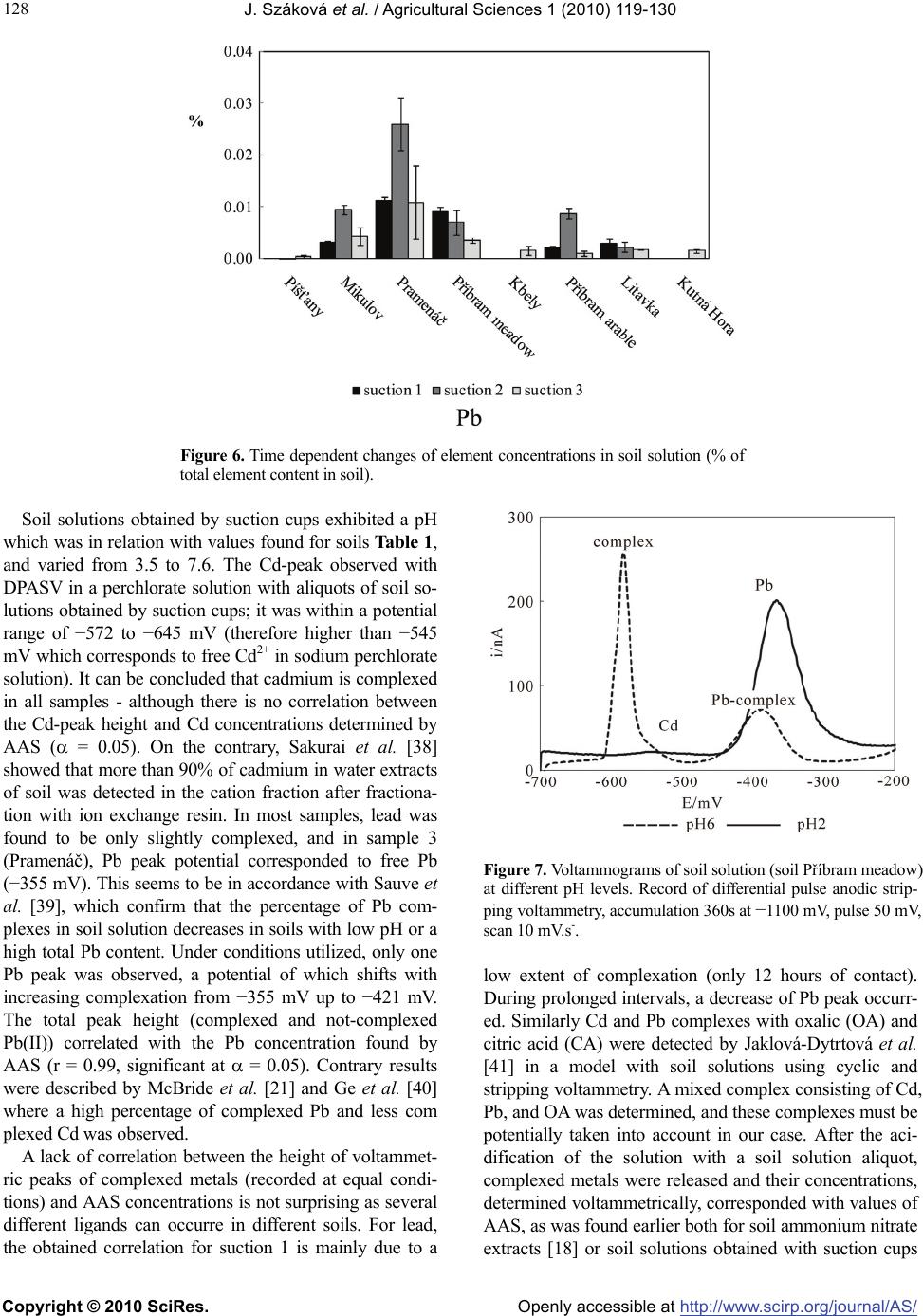 J. Száková et al. / Agricultural Sciences 1 (2010) 119-130 Copyright © 2010 SciRes. Openly accessible at http://www.scirp.org/journal/AS/ 128 Figure 6. Time dependent changes of element concentrations in soil solution (% of total element content in soil). Soil solutions obtained by suction cups exhibited a pH which was in relation with values found for soils Table 1, and varied from 3.5 to 7.6. The Cd-peak observed with DPASV in a perchlorate solution with aliquots of soil so- lutions obtained by suction cups; it was within a potential range of −572 to −645 mV (therefore higher than −545 mV which corresponds to free Cd2+ in sodium perchlorate solution). It can be concluded that cadmium is complexed in all samples - although there is no correlation between the Cd-peak height and Cd concentrations determined by AAS ( = 0.05). On the contrary, Sakurai et al. [38] showed that more than 90% of cadmium in water extracts of soil was detected in the cation fraction after fractiona- tion with ion exchange resin. In most samples, lead was found to be only slightly complexed, and in sample 3 (Pramenáč), Pb peak potential corresponded to free Pb (−355 mV). This seems to be in accordance with Sauve et al. [39], which confirm that the percentage of Pb com- plexes in soil solution decreases in soils with low pH or a high total Pb content. Under conditions utilized, only one Pb peak was observed, a potential of which shifts with increasing complexation from −355 mV up to −421 mV. The total peak height (complexed and not-complexed Pb(II)) correlated with the Pb concentration found by AAS (r = 0.99, significant at = 0.05). Contrary results were described by McBride et al. [21] and Ge et al. [40] where a high percentage of complexed Pb and less com plexed Cd was observed. A lack of correlation between the height of voltammet- ric peaks of complexed metals (recorded at equal condi- tions) and AAS concentrations is not surprising as several different ligands can occurre in different soils. For lead, the obtained correlation for suction 1 is mainly due to a Figure 7. Voltammograms of soil solution (soil Příbram meadow) at different pH levels. Record of differential pulse anodic strip- ping voltammetry, accumulation 360s at −1100 mV, pulse 50 mV, scan 10 mV.s-. low extent of complexation (only 12 hours of contact). During prolonged intervals, a decrease of Pb peak occurr- ed. Similarly Cd and Pb complexes with oxalic (OA) and citric acid (CA) were detected by Jaklová-Dytrtová et al. [41] in a model with soil solutions using cyclic and stripping voltammetry. A mixed complex consisting of Cd, Pb, and OA was determined, and these complexes must be potentially taken into account in our case. After the aci- dification of the solution with a soil solution aliquot, complexed metals were released and their concentrations, determined voltammetrically, corresponded with values of AAS, as was found earlier both for soil ammonium nitrate extracts [18] or soil solutions obtained with suction cups 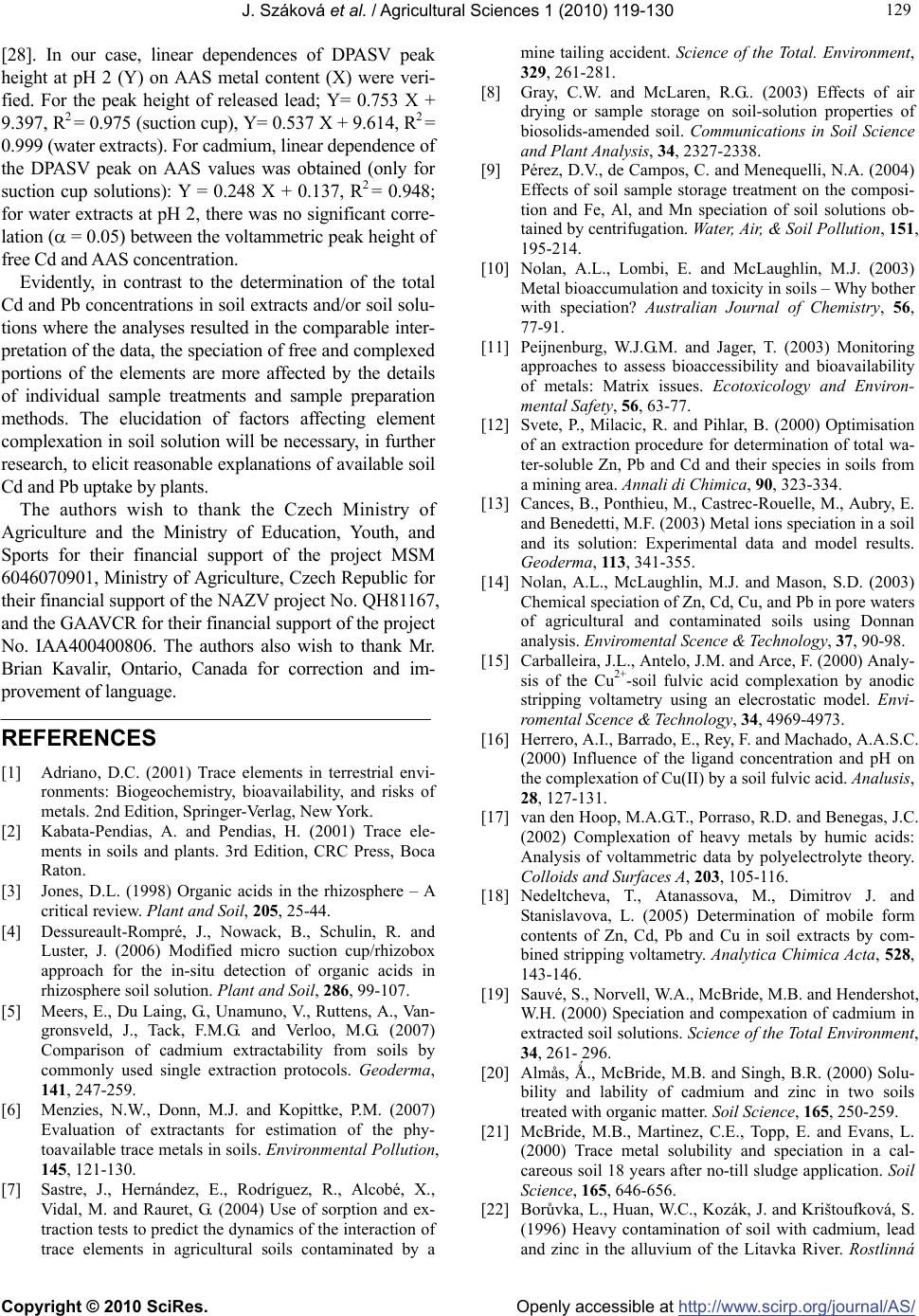 J. Száková et al. / Agricultural Sciences 1 (2010) 119-130 Copyright © 2010 SciRes. Openly accessible at http://www.scirp.org/journal/AS/ 129 129 [28]. In our case, linear dependences of DPASV peak height at pH 2 (Y) on AAS metal content (X) were veri- fied. For the peak height of released lead; Y= 0.753 X + 9.397, R2 = 0.975 (suction cup), Y= 0.537 X + 9.614, R2 = 0.999 (water extracts). For cadmium, linear dependence of the DPASV peak on AAS values was obtained (only for suction cup solutions): Y = 0.248 X + 0.137, R2 = 0.948; for water extracts at pH 2, there was no significant corre- lation ( = 0.05) between the voltammetric peak height of free Cd and AAS concentration. Evidently, in contrast to the determination of the total Cd and Pb concentrations in soil extracts and/or soil solu- tions where the analyses resulted in the comparable inter- pretation of the data, the speciation of free and complexed portions of the elements are more affected by the details of individual sample treatments and sample preparation methods. The elucidation of factors affecting element complexation in soil solution will be necessary, in further research, to elicit reasonable explanations of available soil Cd and Pb uptake by plants. The authors wish to thank the Czech Ministry of Agriculture and the Ministry of Education, Youth, and Sports for their financial support of the project MSM 6046070901, Ministry of Agriculture, Czech Republic for their financial support of the NAZV project No. QH81167, and the GAAVCR for their financial support of the project No. IAA400400806. The authors also wish to thank Mr. Brian Kavalir, Ontario, Canada for correction and im- provement of language. REFERENCES [1] Adriano, D.C. (2001) Trace elements in terrestrial envi- ronments: Biogeochemistry, bioavailability, and risks of metals. 2nd Edition, Springer-Verlag, New York. [2] Kabata-Pendias, A. and Pendias, H. (2001) Trace ele- ments in soils and plants. 3rd Edition, CRC Press, Boca Raton. [3] Jones, D.L. (1998) Organic acids in the rhizosphere – A critical review. Plant and Soil, 205, 25-44. [4] Dessureault-Rompré, J., Nowack, B., Schulin, R. and Luster, J. (2006) Modified micro suction cup/rhizobox approach for the in-situ detection of organic acids in rhizosphere soil solution. Plant and Soil, 286, 99-107. [5] Meers, E., Du Laing, G., Unamuno, V., Ruttens, A., Van- gronsveld, J., Tack, F.M.G. and Verloo, M.G. (2007) Comparison of cadmium extractability from soils by commonly used single extraction protocols. Geoderma, 141, 247-259. [6] Menzies, N.W., Donn, M.J. and Kopittke, P.M. (2007) Evaluation of extractants for estimation of the phy- toavailable trace metals in soils. Environmental Pollution, 145, 121-130. [7] Sastre, J., Hernández, E., Rodríguez, R., Alcobé, X., Vidal, M. and Rauret, G. (2004) Use of sorption and ex- traction tests to predict the dynamics of the interaction of trace elements in agricultural soils contaminated by a mine tailing accident. Science of the Total. Environment, 329, 261-281. [8] Gray, C.W. and McLaren, R.G.. (2003) Effects of air drying or sample storage on soil-solution properties of biosolids-amended soil. Communications in Soil Science and Plant Analysis, 34, 2327-2338. [9] Pérez, D.V., de Campos, C. and Menequelli, N.A. (2004) Effects of soil sample storage treatment on the composi- tion and Fe, Al, and Mn speciation of soil solutions ob- tained by centrifugation. Water, Air, & Soil Pollution, 151, 195-214. [10] Nolan, A.L., Lombi, E. and McLaughlin, M.J. (2003) Metal bioaccumulation and toxicity in soils – Why bother with speciation? Australian Journal of Chemistry, 56, 77-91. [11] Peijnenburg, W.J.G.M. and Jager, T. (2003) Monitoring approaches to assess bioaccessibility and bioavailability of metals: Matrix issues. Ecotoxicology and Environ- mental Safety, 56, 63-77. [12] Svete, P., Milacic, R. and Pihlar, B. (2000) Optimisation of an extraction procedure for determination of total wa- ter-soluble Zn, Pb and Cd and their species in soils from a mining area. Annali di Chimica, 90, 323-334. [13] Cances, B., Ponthieu, M., Castrec-Rouelle, M., Aubry, E. and Benedetti, M.F. (2003) Metal ions speciation in a soil and its solution: Experimental data and model results. Geoderma, 113, 341-355. [14] Nolan, A.L., McLaughlin, M.J. and Mason, S.D. (2003) Chemical speciation of Zn, Cd, Cu, and Pb in pore waters of agricultural and contaminated soils using Donnan analysis. Enviromental Scence & Technology, 37, 90-98. [15] Carballeira, J.L., Antelo, J.M. and Arce, F. (2000) Analy- sis of the Cu2+-soil fulvic acid complexation by anodic stripping voltametry using an elecrostatic model. Envi- romental Scence & Technology, 34, 4969-4973. [16] Herrero, A.I., Barrado, E., Rey, F. and Machado, A.A.S.C. (2000) Influence of the ligand concentration and pH on the complexation of Cu(II) by a soil fulvic acid. Analusis, 28, 127-131. [17] van den Hoop, M.A.G.T., Porraso, R.D. and Benegas, J.C. (2002) Complexation of heavy metals by humic acids: Analysis of voltammetric data by polyelectrolyte theory. Colloids and Surfaces A, 203, 105-116. [18] Nedeltcheva, T., Atanassova, M., Dimitrov J. and Stanislavova, L. (2005) Determination of mobile form contents of Zn, Cd, Pb and Cu in soil extracts by com- bined stripping voltametry. Analytica Chimica Acta, 528, 143-146. [19] Sauvé, S., Norvell, W.A., McBride, M.B. and Hendershot, W.H. (2000) Speciation and compexation of cadmium in extracted soil solutions. Science of the Total Environment, 34, 261- 296. [20] Almås, Ǻ., McBride, M.B. and Singh, B.R. (2000) Solu- bility and lability of cadmium and zinc in two soils treated with organic matter. Soil Science, 165, 250-259. [21] McBride, M.B., Martinez, C.E., Topp, E. and Evans, L. (2000) Trace metal solubility and speciation in a cal- careous soil 18 years after no-till sludge application. Soil Science, 165, 646-656. [22] Borůvka, L., Huan, W.C., Kozák, J. and Krištoufková, S. (1996) Heavy contamination of soil with cadmium, lead and zinc in the alluvium of the Litavka River. Rostlinná  J. Száková et al. / Agricultural Sciences 1 (2010) 119-130 Copyright © 2010 SciRes. Openly accessible at http://www.scirp.org/journal/AS/ 130 Výroba, 42, 543-550. [23] Quevauviller, P., Ure, A., Muntau, H. and Griepink, B. (1993) Improvement of analytical measurements within the BCR–program – Single and sequential extraction procedures applied to soil and sediment analysis. Inter- national Journal of Environmental Analytical Chemistry 51, 129-134. [24] Mehlich, A. (1984) Mehlich 3 Soil Test Extractant: A modification of Mehlich 2 Extractant. Communications in Soil Science and Plant Analysis, 15, 1409-1416. [25] Novozamsky, J., Lexmond T.M. and Houba V.J.G. (1993) A single extraction procedure of soil for evaluation of uptake of some heavy metals in plants. International Journal of Environmental Analytical Chemistry, 51, 47- 58. [26] Kiekens L. and Cottenie A. (1985) In: Leschber, R., Ed., Chemical methods for assessing bio-available metals in sludges and soils. Elsevier Applied Science, London, 42. [27] Nolan, A.L., Zhang, H. and McLaughlin, M.J. (2005) Prediction of zinc, cadmium, lead, and copper avai- lability to wheat in contaminated soils using chemical speciation, diffusive gradients in thin films, extraction, and isotopic dilution techniques. Journal of Environment- al Quality, 34, 496-507. [28] Jaklová-Dytrtová, J., Šestáková, I., Jakl, M., Száková, J., Miholová, D. and Tlustoš, P. (2008) The use of differen- tial pulse anodic stripping voltametry and diffusive gra- dient in thin films for heavy metals speciation in soil so- lution. Central European Journal of Chemistry, 6, 71- 79. [29] Šichorová, K., Tlustoš, P., Száková, J., Kořínek, K. and Balík, J. (2004) Horizontal and vertical variability of heavy metals in soil at a polluted area. Plant, Soil, and Environment, 50, 525-534. [30] Leštan, D., Grčman, H., Zupan, M. and Bačac, N. (2003) Relationship of soil properties to fractionation of Pb and Zn in soil and their uptake into Plantago lanceolata. Soil and Sediment Contamination, 12, 507-522. [31] Davidson, C.M., Ferreira, P.C.S. and Ure, A.M. (1999) Some sources of variability in application of the three- stage sequential extraction procedure recommended by BCR to industrially-contaminated soil. Fresenius Journal of Analytical Chemistry, 363, 446-451. [32] Száková, J., Tlustoš, P., Balík, J., Pavlíková, D. and Balíková, M. (2001) Application of sequential extraction procedure to evaluation of influence of sewage sludge amendment on Cd and Zn mobility in soil. Chemické Listy, 95, 645-648. [33] Miller, W.P., Martens, D.C., Zelazny, L.W. and Kornegay, E.T. (1986) Forms of solid phase copper in copper-en- riched swine manure. Journal of Environmental Quality, 15, 69-72. [34] Wang, Z., Shan, X. and Zhang, S. (2001) Comparison of speciation and bioavailability of rare earth elements be- tween wet rhizosphere soil and air-dried bulk soil. Ana- lytica Chimica Acta, 441, 147-156. [35] Száková, J., Tlustoš, P., Balík, J., Pavlíková, D. and Balíková, M. (2000) Efficiency of extractants to release As, Cd and Zn from main soil compartments. Analusis, 28, 808-812. [36] Tack., F.M.G.., van Ranst, E., Lievens, C. and Vanden- berghe, R.E. (2006) Soil solution Cd, Cu and Zn con- centrations as affected by short-time drying or wetting: The role of hydrous oxides of Fe and Mn. Geoderma, 137, 83-89. [37] Tawinteung, N., Parkpian, P., DeLaune, R.D. and Juq- sujinda, A. (2005) Evaluation of extraction procedures for removing lead from contaminated soil. Journal of Environmental Science and Health Part A, 40, 385-407. [38] Sakurai, Y., Murayama, S., Makino, T., Maejima, Y. and Sugahara, K. (2007) Chemical form of soluble cadmium and copper in arable soils and its implication to their mo- bility. Japan Agricultural Research Quarterly, 41, 139 -145. [39] Sauvé, S., McBride, M.B. and Hendershot, W.H. (1997) Speciation of lead in contaminated soils. Environmental Pollution, 98, 149-155. [40] Ge, Y., Murray, P. and Hendershot, W.H. (2000) Trace metal speciation and bioavailability in urban soils. Envi- ronmental Pollution, 107, 137-144. [41] Jaklová-Dytrtová, J., Šestáková, I., Jakl, M. and Navrátil, T. (2009) Electrochemical detection of cadmium and lead complexes with low molecular weight organic acids. Electroanalysis, 21, 573-579. |

